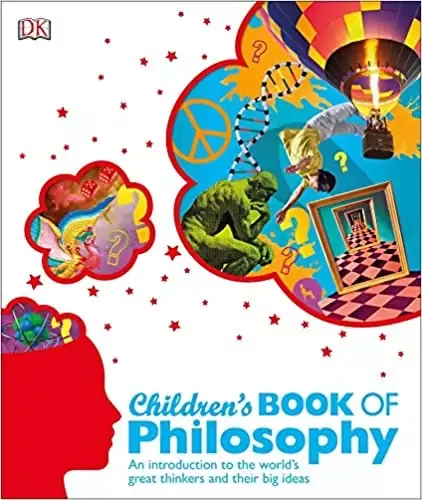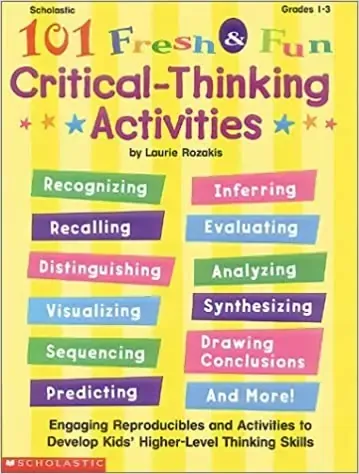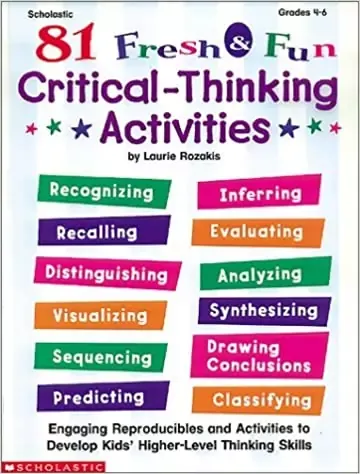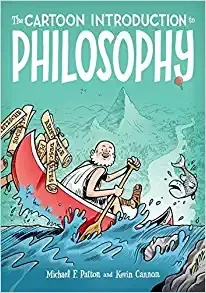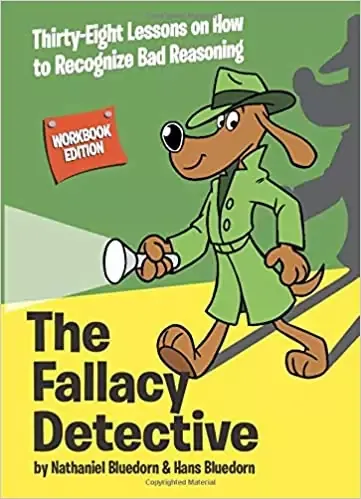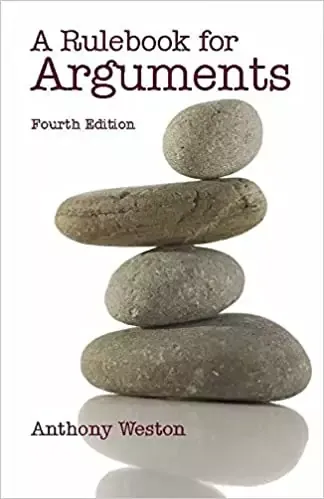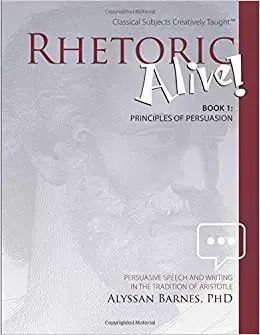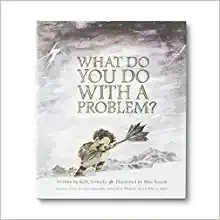1. Children's Book of Philosophy
College students look at this a bit shallow. A brief introduction to the lives, thoughts, and social issues of some philosophers is suitable for elementary school students.
Learn to think big and tackle life's trickiest questions, such as "What am I here for?" and "Who decides what's right and wrong?".
Children’s Book of Philosophy is a perfect introduction to the great thinkers who’ve tried to make sense of the world. From ancient times to the modern day, people have asked questions such as “Who am I?”, “Is the world real?”, and “Is it ever right to tell a lie?”.
Meet famous philosophers from history including Socrates, Confucius, Immanuel Kant, Simone de Beauvoir, and many others who have studied the complex issues of everyday life.
Using simple text and fun illustrations to get your mind working, the Children’s Book of Philosophy will make big ideas easy to understand. Examine the problems that have puzzled people for hundreds, or even thousands, of years – and ponder your way through them in clear and logical stages.
The book's lively approach is designed to encourage children to start thinking for themselves and to show them that anyone can be a philosopher.
2. 101 Fresh & Fun Critical-Thinking Activities
Engaging Reproducibles and Activities to Develop Kids' Higher-Thinking Skills Help students of all learning styles and strengths begin to think critically.
Includes 101 cross-curricular activities to reinforce specific skills such as recognizing and recalling or inferring, and drawing conclusions. Complete with reproducible suggestions for integrating the activities into your curriculum.
3. 81 Fresh & Fun Critical-Thinking Activities
Engaging Reproducibles and Activities to Develop Kids' Higher-Level Thinking Skills. 81 creative cross-curricular activities designed to help students of all learning styles think critically.
Each activity reinforces a specific critical thinking skill such as recognizing and recalling, evaluating, and analyzing. Comes complete with student reproducible and suggestions for integrating the activities into your curriculum with ease.
4. The Cartoon Introduction to Philosophy
In my impression, this book seemed to be seen at the International Book Fair, because I thought it was great when I saw it. I should buy it soon, or I should read it as soon as I buy it. Logically speaking, it should be read in twos or twos. The book, why I took so long time, I find it very mysterious.
But I really like this book! I like everything! Not only is the style of painting good but also the various ideas and theories are perfectly integrated into a continuous story. It is like watching a montage movie.
The fragments are seamlessly connected, and the landscapes that look like embellishments are metaphors of meaning. As a person who only has pure text functions and cannot understand images, like a notepad, I am fascinated by the fact that the author can use such a clever example to transform concepts into pictures and be clean and clear. How can XD come up with such an expression?
And as a pure word processor(?), I think this is great because the text content of this book is also excellent. Most simply, XD is very elegant and popular, and it is easy to lift weight. The way XD expresses this is humorous and humorous, without compromising the profoundness of the connotation.
Although it is only a brief introduction to the point, it has already outlined the leading thesis, which is the destination that one wants to reach, that is what the individual has to think about. What happened, just like the river is used as a metaphor in the whole book, the whole process of boating, the mind is quite responsive.
The translator must be praised here. On the whole, the translation is very tasteful, which guarantees a smooth and pleasant trip on the water. Also, taking water as the axis is always the point that my wife pokes in me.
I sincerely recommend this exciting fantasy drifting trip.
5. The Fallacy Detective
An introductory book to logic. A summary of various fallacies, concise content, easy-to-understand, and easy-to-understand, is not the same as stacking terms of many similar books, which are boring and lengthy. Avoid children’s brains from becoming a must-read for others’ minds. Suitable for children and adults over 12 years old.
The Fallacy Detective has been the best-selling text for teaching logical fallacies and introduction to logic for over 15 years.
"Can learning logic be fun? With The Fallacy Detective, it appears that it can be. I thoroughly enjoyed this book and would recommend it to anyone who wants to improve his reasoning skills."--Tim Challies, curriculum reviewer
"Cartoon and comic illustrations, humorous examples, and a very reader-friendly writing style make this the sort, of course, students will enjoy."--Cathy Duffy, homeschool curriculum reviewer
"I really like The Fallacy Detective because it has funny cartoons and silly stories, and teaches you a lot!"--11 Year Old
What is a fallacy? A fallacy is an error in logic a place where someone has made a mistake in his thinking. This is a handy book for learning to spot common errors in reasoning.
- For ages twelve through adult.
- Fun to use -- learn skills you can use right away.
- Peanuts, Dilbert, and Calvin and Hobbes cartoons.
- Includes The Fallacy Detective Game.
- Exercises with answer key.
6. The Art of Argument
Junior high-aged students will argue (and sometimes quarrel), but they won't argue well without good training. Young teens are also targeted by advertisers with a vengeance. From billboards to commercials to a walk down the mall, fallacious arguments are everywhere you look.
The Art of Argument was designed to teach the argumentative adolescent how to reason with clarity, relevance, and purpose at a time when he has a penchant for the why and how. It is designed to equip and sharpen young minds as they live, play, and grow in this highly commercial culture.
This course teaches students to recognize and identify twenty-eight informal fallacies, and the eye-catching text includes over sixty slick and clever, ?phony advertisements. for items from blue jeans to pick-up trucks, which apply fallacies to a myriad of real-life situations.
7. A Rulebook for Arguments
The language of this book is easy to understand, and the subject matter is also my favorite. I have read "Beyond Feelings" before. It is about critical thinking, and this book happens to be the same. Since you want to be critical, it will inevitably cause controversy. Therefore, this book is about controversy. It teaches you to better argue and master critical thinking.
Speaking of this book, to form an argument, you need to have arguments and arguments. If the arguments are very correct, or you have to debate your arguments, the arguments should be chosen well, and the arguments should be simple and accurate. Usually, a conclusion can be explained by many arguments, but the arguments should be representative.
If you have cited a few examples and reached a conclusion, you can find out whether there is a counterexample by yourself, and find out that you can modify your argument according to this counterexample.
The example in the book is: that all fast food is junk food, we can cite countless examples, such as fried chicken legs, Coca-Cola, etc., but if you think about counterexamples, for example, the vegetable-based burgers in the book, this one Can't be called junk food.
At this time, based on counterexamples, the conclusion can be changed to Many fast foods are junk food, so taking counterexamples is a very good way to understand and modify your arguments more deeply.
And some arguments can be used as an analogy. For example, there are no humans in outer space. You can use an analogy. Because there are many galaxies in outer space, there will definitely be some galaxies like our solar system, and there may be life in stars like the Earth.
I don’t feel much about the resource part. What I am more impressed with is that the author tells us to be cautious when using online resources, because many of them are not very rigorous, so you have to use your sharp eyes to find them.
There is also the knowledge of logic, which I have learned in many mathematics books, that is, inverse negation propositions and the like.
This book is short and concise, very practical, and can be turned over from time to time, it is recommended.
8. Rhetoric Alive!: Principles of Persuasion
A one-semester or yearlong course for students in grades 10-12. Rhetoric Alive! Book 1: Principles of Persuasion, written by Alyssa Barnes, an experienced rhetoric teacher with a Ph.D. in rhetoric, is a clear, compelling, and delightful text on rhetorical theory and practice.
The highly engaging Rhetoric Alive! explores the principles of winsome speech as developed in the foremost text on persuasion, Aristotle's Rhetoric. The fifteen chapters of Rhetoric Alive! step through the essential components of persuasion: the three appeals; Ethos (speaker's credibility), Pathos (audience's emotion), and Logos (argument's reasoning), the three types of speech; Deliberative (exhort or dissuade), Ceremonial (praise or blame), Judicial (accuse or defend), and the five canons; Invention, Organization, Style, Memory, Delivery.
Each chapter includes an exemplary classic text for analysis and discussion, spanning from Pericles's 'Funeral Oration' to Martin Luther King, Jr.'s, 'Letter from Birmingham Jail.' Students also have plenty of practice developing their own rhetorical skills through weekly workshops, imitation assignments, and oratory presentations.
9. Mastering Logical Fallacies
After reading this book, you feel that politicians, celebrities, and news media, especially couples quarrels, are full of loopholes.
Logic is a field with a long history, but unfortunately, it seems that the popularization of logic in the current society is insufficient, whether at home or abroad. Logic teaches how to make yourself a rational person.
Although behavioral economics demonstrates that irrationality is an undeniable and important part of human nature, logic is the best way to help everyone overcome irrationality to the maximum.
Tools are of extraordinary significance. The format of this book is quite simple. It is listed in alphabetical order of the logical fallacy names. Each fallacy is dealt with in a unified thematic structure of formal explanations, practical examples, degree of influence, and coping methods, so you can read one without any problems.
Instead of using more than a dozen pages a chapter at a time, it is obviously more suitable for short-term activities such as riding in a car and sitting in the toilet.
The author did not include all the fallacies, this book is not enough to fit 200 pages, but the fallacies listed are all visible in daily life, which is of reference value and entertaining. In short, it's not a textbook, but you can read it when it's okay.
10. What Do You Do With A Problem?
This book was created by Kobi Yamada. He is a dad who is keen on innovation and experimentation. In the book, he tells his two children that “one idea can change everything.” This belief makes Him write his own thoughts into the story and pass them on to more children.
At the same time, this book was recognized by the American publishing industry, was awarded the "Independent Publisher" award, stood out from many children's picture books, and quickly made it to the best-selling list of Amazon in the United States. No wonder the Americans would give it as a gift to the British King George.
If you have an idea, how would you treat it? Especially different, risky, or crazy ideas? Would you hide it? Walk away from it? Pretend it’s not yours?
This story is about a great idea and the kid who brought that idea to the world. The self-confidence of the child increases and this idea also develops.
Images full of symbolic meaning and narrative function combine fragments and abstract concepts with coherent and concrete situations to create a charming imaginary space and atmosphere.
The egg-shaped character represents the idea, symbolizing the smallness and fragility of the idea when it is born, and at the same time it contains the potential for growth and change, creating a charming imaginary space and atmosphere, and the image tension accurately expresses the emotional depth and dramatic effect.
This story is dedicated to readers (regardless of age) who once thought their ideas were too big, weird, and too difficult. This story inspires you to embrace your idea, give it room to grow, and then see how it develops. Your thoughts will not disappear. In fact, it has just begun...
How Promoting Critical Thinking in Kids Through Books?
Critical Thinking for Kids: Amazon That book has all different themes and topics for math, pictures, words, and other really clever puzzles, including some unusually challenging sudokus.
This was. Children's Books that Promote Critically Thinking Your Fantastic, Elastic Brain: Stretch it, Shape it This book shows children how the brain is flexible and how trying new things, doing things differently, and thinking in new ways is how we stretch the brain.
While stories about creating something concrete can be used to introduce children to critical thinking, they need to see how critical. Critical Thinking Books for Children and Teens – Apparent Stoic Critical Thinking Books for Children and Teens.
These books teach children about metacognition and the best books on critical thinking and problem-solving, Raise your child to be a critical thinker and an innovator, and embrace diversity in thinking.
These books teach children about metacognition. The Critical Thinking Child Our Critical Thinking Boot Camp for Kids learning tools allow you to do just that, through a series of fun, effective, and intriguing thinking questions. Picture Books for Developing Critical Thinking Skills.
When we think of bringing up kids to succeed and put emphasis on avoiding. Critical Thinking Through Children's Literature - we suggest how these behaviors can be developed through children's literature.
Examples of learning experiences are noted in two children's books.
The best critical thinking books can stimulate your interest and greatly expand your knowledge and skills.
- Critical Thinking Skills - Focus on the Family Teaching children to think critically, whether in books or about what people say, is a skill. It was the first step in teaching my kids the critical thinking process.
- How Reading Improves Critical Thinking - Critical thinking is an important skill for children to develop as they grow. Good critical thinking skills can be attained in a variety of ways. Reading mystery books.
Conclusion of the Critical Thinking Books for Children and Teens
Thinking determines the choice, and choice determines life. To change, we must start with speculation.
May every child, in the rapidly changing 21st century, have the ability to make wise judgments, bring inner stability, and realize their potential.


